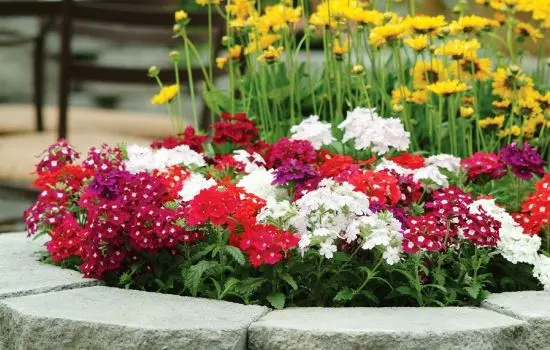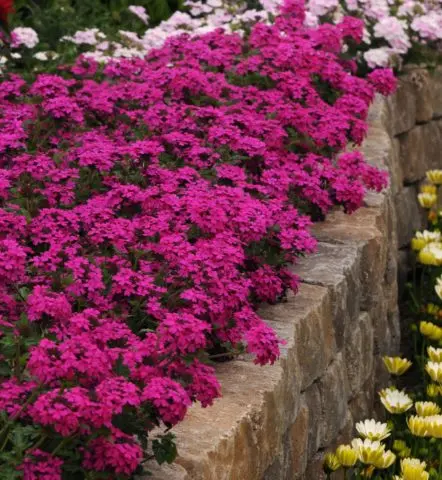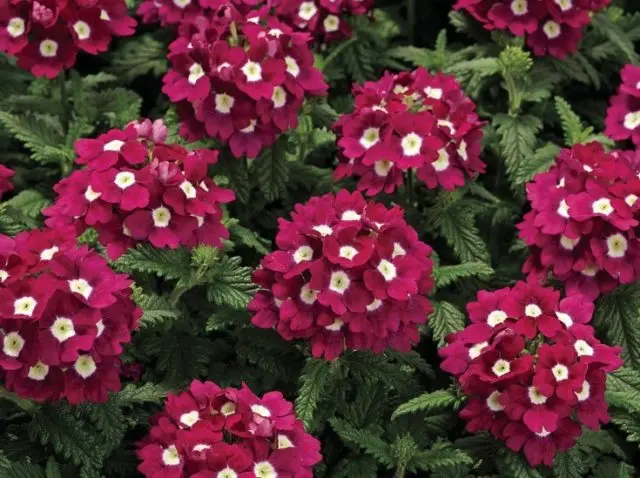Contents
Among the creeping plants for the garden, ampelous verbena stands out. It can be successfully bred as an indoor flower, used in pots on the streets, and also planted in open ground. Dense branches with lush buds cover the soil and pair well with most other flowers. Planting and caring for ampelous verbena will not cause difficulties even for novice gardeners, if they know some of the secrets of agricultural technology of this crop.
Description of ampel verbena
Verbena ampelnaya is a perennial plant with dense shoots that densely cover the ground. The leaves are simple in structure, fairly rigid, covered with hairs. Flowers have 5 petals of various shades:
- red;
- pink;
- purple;
- blue.
One stem gives up to 30 inflorescences, so the bush blooms very luxuriantly. The plant is unpretentious, although it requires an abundance of sunlight and moderate heat (prolonged frosts below +5 ° C are not allowed). The culture is responsive to feeding. Ampel verbena needs additional fertilizer more than erect varieties.
Application in landscape design
Thanks to its lush flowering and variety of colors, ampelous verbena fits well into any garden. It is used in different versions:
- in unusual pots to decorate the recreation area;

- ground cover plantings perfectly hide the soil;

- in a cache-pot on arbors, fences;

- in mixborders and discounts;

- in street containers near the entrance, along the paths of the garden.

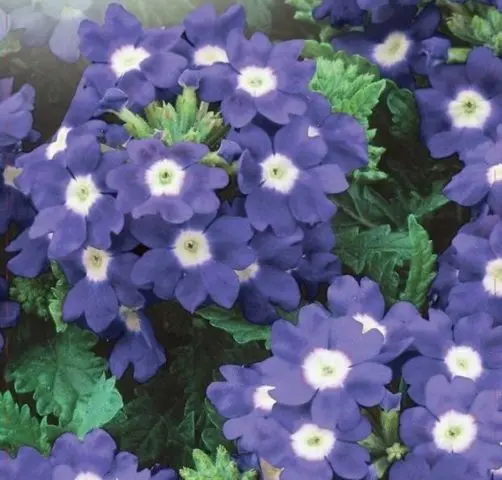
Seedlings can be planted both in the ground and on a small hill
Features of reproduction
Verbena ampelous can be propagated:
- seeds. Seedlings are grown, which are transferred to open ground in mid-May;
- layers. Pin a branch to the ground, sprinkle with soil and get 2-3 layers;
- cuttings.
Cuttings are considered one of the most effective ways to propagate ampelous vervain. The procedure starts at the end of February. Pre-prepare a mixture of sand, peat (in equal amounts) and perlite (a few pinches). Sequencing:
- cut cuttings from the upper shoots. It is necessary that they have 4-5 sheets;
- the lower leaves are removed;
- cuttings are immersed in Kornevin’s solution;
- planted in moist soil and grown under glass at a temperature of 22-25 ° C.
Verbena ampelnoy variety
Verbena ampelnaya is distinguished by a large species diversity. In garden landscape design, different varieties can be used both together and separately.
Tiara Red Impr
Tiara Red Impr is one of the most beautiful varieties of ampelous verbena with red flowers. Culture is unpretentious, grows very quickly. The branches of this verbena are densely strewn with inflorescences.
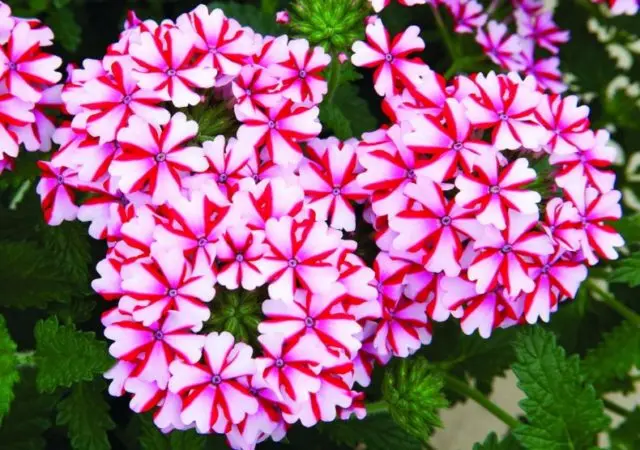
Verbena ampelnaya Tiara Red is suitable for growing outdoors and at home
Empress Peach
Empress Peach is an interesting variety with creamy, pale yellow flowers. Shoots are small (up to 50 cm), but compact.
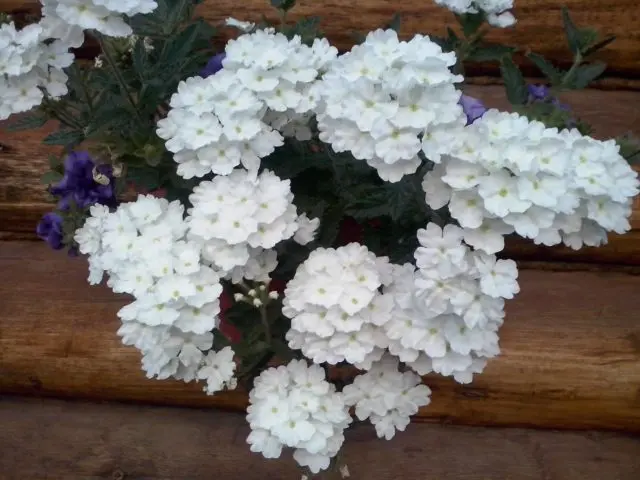
This variety of ampelous verbena blooms luxuriantly throughout the summer.
Imagination
This is a purple variety of ampelous vervain with rather large flowers.
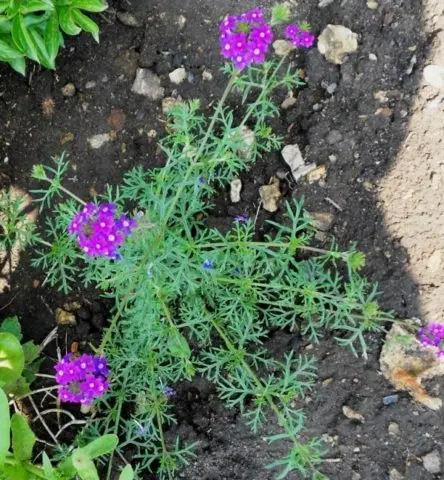
The bush grows well both in height and in width, so it almost does not require pruning.
Verbena ampelnaya Imagination goes well in compositions with bright orange-yellow flowers.
Obsession Burgundy
Ampel verbena Obsession Burgundy is distinguished by interesting flowers of cherry, wine tones. Large inflorescences look good on a compact bush.
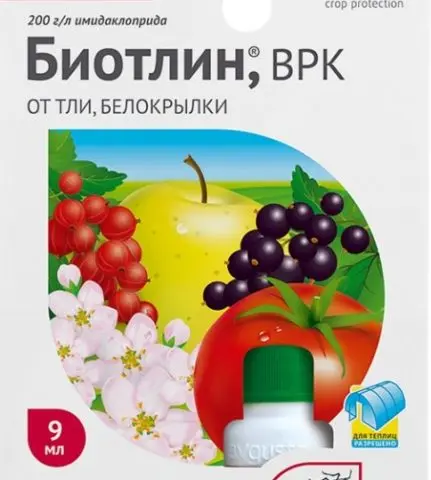
The flowers of this variety of ampelous verbena are very large – up to 7 cm in diameter.
Temari
This ampelous verbena produces beautiful lilac-pink flowers. The branches are drooping, low, but dense, completely covering the ground. The leaves are practically not cut.
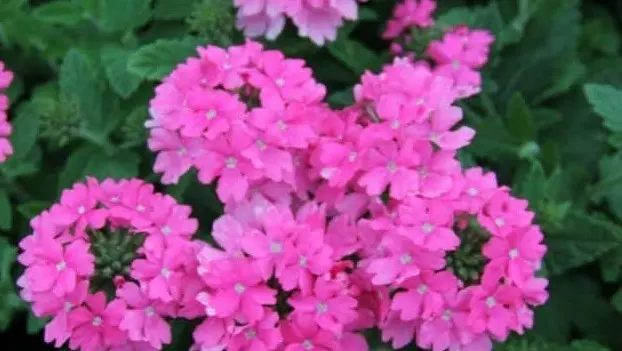
The inflorescences of this variety of ampelous verbena are round, symmetrical, and bright flowers contrast well against the background of dark green leaves.
Amethyst
Another attractive variety of ampelous verbena with pale lilac flowers with a white core. Blooms all summer.
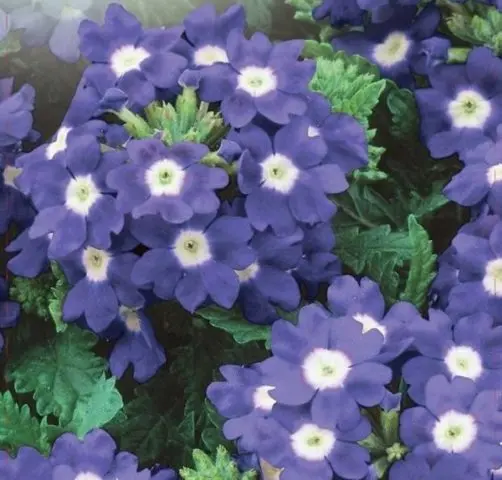
Verbena Ametist produces soft lilac and blue flowers
Killing
A very attractive variety of ampelous verbena with branched shoots and inflorescences in the form of corymbs. Characteristically long flowering – until the beginning of autumn.
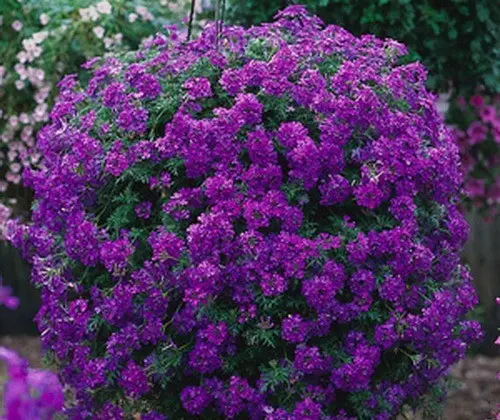
The flowers of this variety of ampelous verbena can be not only lilac, but also other shades
Lanai Candy Cane
This is one of the last varieties of ampel verbena, obtained several years ago. Pink petals with a bright red border look really chic.
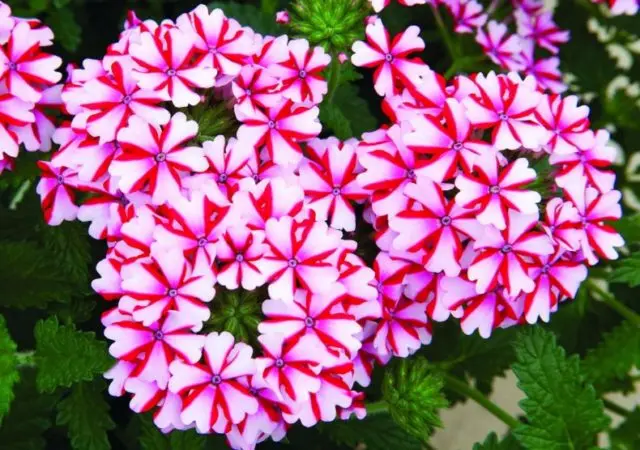
This variety of ampelous verbena produces flowers until the beginning of September
Estrella Voodoo Star
Another bicolor variety. The coloring includes shades of bright red and pure white. At the same time, the plant is unpretentious and tolerates even a dry period quite well.
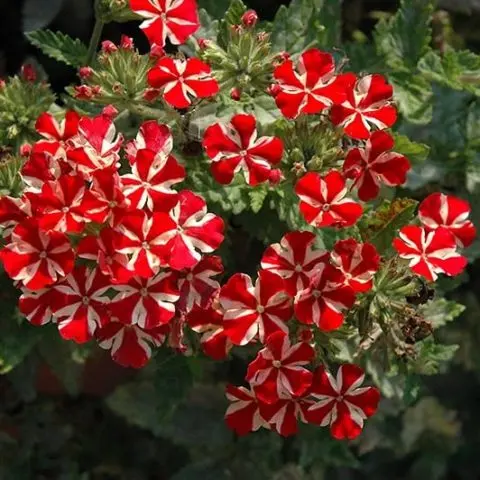
Estrella Voodoo Star ampelous verbena bush is very compact, shoots reach 30-40 cm in length
Quartz XP Silver
Attractive cultivar with silvery white flowers. The plant is small – the branches grow up to 30 cm. It looks very beautiful both in the garden and in the pots.
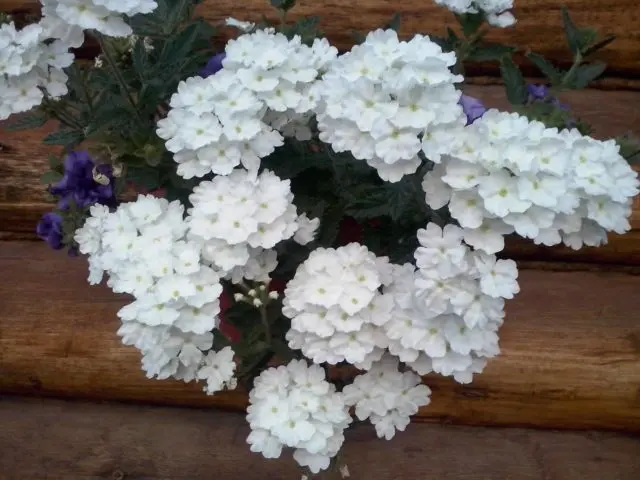
Milky white flowers look like snowflakes from a distance
Planting ampelous verbena for seedlings
Verbena ampelous can be grown from seedlings. To do this, you need to purchase seeds in advance, prepare the soil and planting containers. Growing conditions are standard: timely watering, good lighting and a fairly high (room) temperature.
Deadlines
You can plant seeds both in spring and summer (until the beginning of June). However, the best time is March or April. The sprouts will receive enough sunlight, thanks to which the verbena will quickly gain green mass. If the deadline is missed, it is no longer necessary to purchase seeds and plant them in the summer. It is better to buy ready-made seedlings.
Tank and soil preparation
Soil for seedlings can be found in any store or make a mixture yourself:
- 1 part of garden land;
- 2 parts of peat;
- 0,5 pieces of sand.
You can also use a mixture of sand and perlite for cultivation. The soil should first be disinfected with a weak solution of potassium permanganate (1-2%). Then the earth is dried, and warmed up immediately before planting.
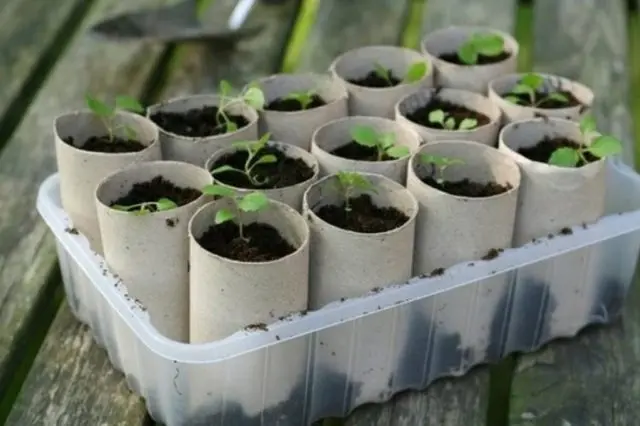
It is better to plant verbena seeds in individual containers – plastic cups, small pots or bowls.
Seeding algorithm
Proper planting guarantees good germination. You can act according to the following instructions:
- Before planting, the seeds are warmed up a little by putting them on the battery for 1 hour.
- Sow 2-3 seeds in each glass. It is not necessary to deepen – it is enough to lightly sprinkle with soil.
- Moisturize, put in a warm place (+ 24-25 ° C) and cover with glass or film.
- After the appearance of the third leaflet, they are seated.
In this case, the pot is placed on the battery (several hours a day), and put in the refrigerator for the night. This is repeated for 3 days, after which shoots appear.
Some varieties of ampel verbena require stratification, which is indicated by a warning on the package with seeds. You can carry it out in the standard way: 5 days before planting, place the seeds on a damp towel, put it in a plastic bag and leave it in the refrigerator.
Growing seedlings
Seedlings are grown on the southern or eastern window, where the maximum amount of sunlight is observed. In March, the days are still short, besides, the weather is cloudy, so you need to provide lighting with a phytolamp, creating a day length of 12-13 hours.
Watering provide moderate. Top dressing at the stage of growing seedlings is done only once – after 2 weeks. A complex fertilizer is applied, it is better to take a slightly lower dosage so that the roots do not “burn out” due to the abundance of nitrogen.
Then the side branches are activated, and ampelous verbena will quickly gain weight.
Planting and caring for ampel verbena in the open field
Ampelous verbena is transplanted into open ground already in mid-May. It can be placed in the garden or outdoor containers. 10 days before this, it is useful to harden the seedlings by lowering the daytime temperature to 17-18 ° C.
Transplant into the ground
Transplanted seedlings when return frosts are no longer expected. In most regions of Our Country, this is mid-May, but in the south, ampelous verbena can be planted at the end of April. And in Siberia, the period may increase slightly – until the last ten days of May.
The place is chosen sunny, open, because the plant loves light very much. If possible, this should be a hill – stagnant moisture has a bad effect on the root system. When planting, they are guided by the fact that the branches will completely cover the soil. Therefore, the density is quite high – 25-30 cm can be left between adjacent verbenas.
Algorithm of actions:
- The site is cleaned and dug to a shallow depth.
- Dig several holes of shallow depth (it is necessary that the roots fit freely in them).
- Drain with a layer of pebbles, brick fragments or other stones.
- Prepare a mixture based on garden soil and humus (2: 1) with wood ash (2-3 tablespoons).
- Root seedlings and cover with soil.
- Water and mulch.

Verbena seedlings are not placed too tightly, they grow well and cover the ground
Watering and top dressing
If it is warm enough outside (at night not below 10 ° C), ampelous verbena seedlings take root quickly. Further care for them is quite simple. Water as needed: the surface of the soil should be slightly damp. If the roots are mulched, watering will be needed only if there is no rain for a long time.
After transplantation, any nitrogen fertilizer can be applied to accelerate growth.
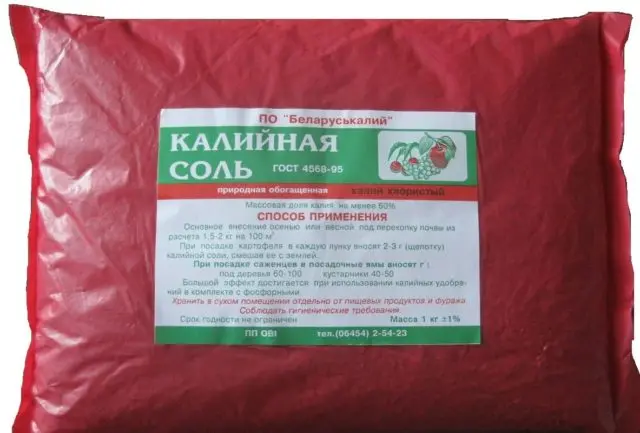
At the stage of bud formation and during flowering (1-2 times), superphosphates and potassium salt are added
An alternative way is to use a long-acting complex fertilizer. It can be applied 3-4 times per season with an interval of 1 month.
Loosening, weeding, mulching
It is recommended to mulch the roots of ampelous verbena immediately after planting. This can be done using sawdust, peat, spruce branches and other improvised materials. Such a layer will not only retain moisture, but also prevent the growth of weeds.
You can loosen the soil once a month – after fertilizing. In this case, the nutrients will be absorbed faster by the roots. Weeding as such is not needed, although sometimes it is done anyway. Verbena is very good at dampening the growth of weeds, since its dense cover deprives them of access to light.
Trimming
Pruning must be done, otherwise the bushes will grow in height, but not in width. When a shoot is formed 7-8 cm high, pinch the top with your fingers. After this, the active growth of lateral shoots will begin.
In the future, pruning is done only if necessary – bushes are formed and old or damaged shoots are removed. If the branch is too long, do not cut it. It is better to pin in several places to the soil and get cuttings that will germinate very quickly and cover the surface with a green carpet.
Even minimal care will ensure lush and long flowering of ampelous verbena.
How to save ampel verbena in winter
Verbena ampelnaya is a perennial plant, but in most regions of Our Country it can only winter at home. There are exceptions to this rule:
- In the southern regions, verbena can be left in the soil – short-term frosts down to -2 ° C are not dangerous for it. If there is no certainty, it is better to transfer it to the house.
- Verbena straight variety is characterized by moderate winter hardiness, so the plant can spend a cold period in the soil. However, it must be cut off and covered with spruce branches.
Before the onset of the first frost, the vervain is cut so that the length of the remaining shoots does not exceed 10 cm. When digging, you should try to ensure that there is as much earth as possible on the roots. The plant is placed in pots or other containers and stored at a temperature of 10-12 ° C (indoors, on insulated balconies or loggias).
Pests and diseases
Verbena is extremely rarely affected by fungal diseases. It is quite resistant to pests, although caterpillars and aphids feed on its foliage. A simple way to fight is to spray the foliage with an aqueous solution of laundry soap shavings (1 tbsp per 2 liter of liquid). You can also use other folk remedies – a solution of baking soda, an infusion of onion peel or mustard powder.
If these measures do not help, it is advisable to use proven insecticides.
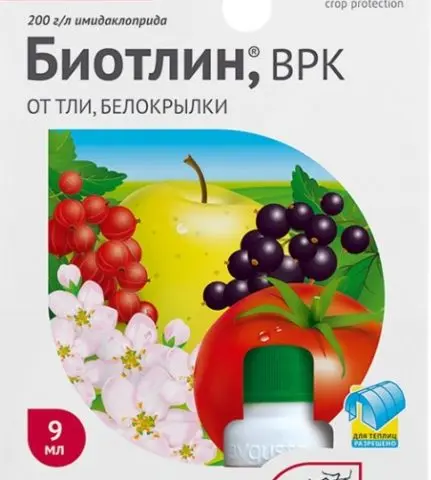
Can be treated with Biotlin, Decis or Confidor
The procedure is carried out in calm and clear weather (after sunset).
Conclusion
Planting and caring for ampel verbena is not difficult, but requires compliance with the rules. Culture will decorate the garden, gazebo, veranda and other recreation areas. This is an unpretentious plant that gives beautiful flowers of different shades. Flowering continues all summer, so the garden looks beautiful and well-groomed.










